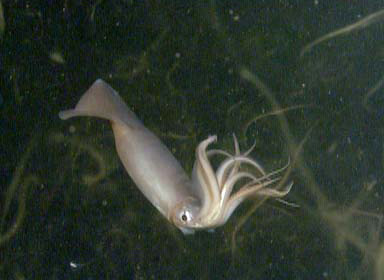Humboldt Squid
Also known as the Jumbo Squid, Jumbo Flying Squid, or the Diablo Rojo (Red Devil in Spanish), the Humboldt Squid is a large squid that is found in the Humboldt Current, in the east Pacific Ocean. They are found at depths of 660 – 2,300 feet, from California to Tierra del Fuego. However, it has been recntly found that this species is spreading norhtwards to Oregon, Washing, British Columbia, and Alaska.
Humboldt squid are carnivorous marine invertebrates. They move in shoals of up to 1,200 individuals. Some of these groups have made it to the Puget Sound. They swim at up to 15 mph / 13 kn / 24 km per hour and are propelled through the water by their hyponome, which is a siphon that they eject water out though. They also have two diamond shaped fins, however these are less used for locomotion purposes. Their tentacles have suckers with sharp teeth, and when they attack their prey, they grasp onto them and drag it towards their large and sharp beak.
As the Spanish have called them the Diablo Rojo, it is no wonder that these squids have a reputation of being aggressive. As scary as the Humboldt Squid’s name is, it is thought that they do not really endanger human beings. The only reports of agression towards humans are when scuba divers used reflective diving gear or flashing lights, and these squids thought that it was a sign of provocation towards them. When these animals are not being hunted or are not feeding, they are display curious and intelligent behaviour.
Recent research suggests that they are only aggressive when feeding. When they are not doing this, they are passive. However, some specimens do resort to cannibalism. Some are ready to attack injured or vulnerable squids of their own shoal. This may account for a large proportion of this squid’s rapid growth.
Humboldt squid grow up to 1.75 metres in length, and weigh up to 50 kg. They have a lifespan of up to 1 to 2 years. Like other squids, they have chromatophores on their skin which enable them to change skin colour from white to a deep purplish red. Some Scientists believed that this may be used in some sort of complex communication system.
Experts also say that they are social creatures when feeding. They will hunt for krill and small fish in a cooperative way, which is a unique behaviour amongst invertebrates. They usually hunt during the night time at the surface, as their eyes have good night vision, which allows them to hunt their prey easily. Other than small fish and krill, they also also eat crustaceans, other cephalopods, and copepods.
Traditionally, this species has been caught to serve the European markets. These markets are mainly France, Spain, and Italy. Other markets include Japan, China, Russia, and South East Asia. It has also become increasingly popular in the North and South American markets. In order to fish them, they are fished at night time because it is easier to lure them with light at the surface. The most important areas for fishing the squid since the 1990’s are Mexico and northern Peru.



